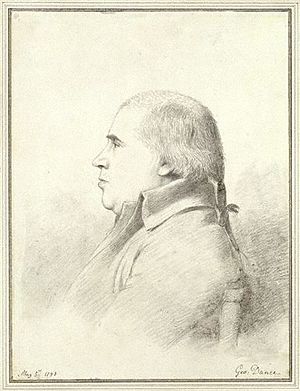William Seward (anecdotist) facts for kids
William Seward (born January 1747 – died April 24, 1799) was an English writer and collector of interesting stories. He was known for his books filled with short, true tales, called anecdotes. In London, he was good friends with famous people like Samuel Johnson, the Thrale family, and the Burney family.

Contents
Early Life and Education
William Seward was born in London in January 1747. He was the only son of William Seward, who was a partner in a large London brewery called Calvert & Seward.
He started school near Cripplegate. In 1757, he went to Harrow School, a well-known school. He also spent some time at Charterhouse School. Later, in 1764, he began studying at Oriel College, Oxford University.
Travels and Literary Friends
After finishing university, Seward traveled a lot. He visited Italy and other parts of Europe. He was quite wealthy, but he did not like business. When his father passed away, he sold his share in the family brewery.
Seward was a cultured person and a great talker. These skills helped him become part of London's literary scene. He was especially close to the Thrale family, who were also involved in brewing, at their home in Streatham.
Meeting Samuel Johnson
It was at the Thrales' home that Seward met Samuel Johnson, a very famous writer. They became good friends. Seward joined the Essex Head Club, which Johnson had started. Johnson even wrote a letter of introduction for Seward to James Boswell when Seward visited Edinburgh and the Highlands in 1777.
Seward continued to travel. In August 1781, he toured western England. He worried a lot about his health and saw a doctor or chemist in almost every town he visited, according to Fanny Burney. Two years later, he was in Paris and then in Flanders, where he studied paintings by Claude Lorrain.
Joining Important Societies
Seward was also recognized for his knowledge. In 1779, he became a member of two important groups: the Royal Society, which focuses on science, and the Society of Antiquaries, which studies history and old things.
When Samuel Johnson died in 1784, Seward helped the scholar Samuel Parr write Johnson's epitaph, which is a message on a tombstone.
Seward's Conversations
Seward was known for his lively conversations. In 1776, he introduced the music scholar Charles Burney and his family to the Thrales. This led to a close friendship between Hester Thrale and Fanny Burney.
Fanny Burney's many letters and diaries show how much she liked Seward. In March 1777, she described him as "a very polite, agreeable young man." Her younger sister, Charlotte Ann Burney, wrote in 1782 that Seward would always greet her warmly. He would even pull a chair into the middle of the room for her and promise to "stand by you, and amuse you."
In May 1792, Fanny Burney found him very entertaining. She wrote that he "entered into a gay conversation, upon all sorts of subjects, which detained me, agreeably enough."
Seward also knew and helped other well-known people. These included the scholar Richard Porson, the writer Thomas Paine, and the poet Anna Seward (who was not related to him).
His Final Days
Fanny Burney also wrote about Seward just before he died. On May 2, 1799, she shared that he expected his end was near. He spent almost a whole morning with her, talking about "other times," as he called it. They remembered their days at Streatham with Dr. Johnson and the Thrales.
Seward had become very heavy. He passed away from a condition called dropsy (a swelling caused by too much fluid in the body) on April 24, 1799. He was at his home in Dean Street, Soho. He was buried in his family's burial place in Finchley on May 1.
Seward's Writings
William Seward wrote many articles. He contributed a series called "Reminiscentia" to the Whitehall Evening Post. He also shared anecdotes and new literary discoveries with Thomas Cadell's Repository and the European Magazine. The European Magazine even featured his portrait and a long article about him after he died.
Seward's articles called "Drossiana" in the European Magazine (starting in October 1789) became the basis for his most famous work. This was a five-volume collection titled Anecdotes of some Distinguished Persons (published between 1795 and 1797). A new edition came out in 1804.
In 1799, he published two more volumes called Biographiana. The Gentleman's Magazine praised him for being good at capturing the main qualities of his subjects. The poet Thomas James Mathias jokingly called Seward a "publick bagman for scraps" (meaning he collected bits of information). However, Mathias also said Seward's books were entertaining and that he was the best collector of anecdotes after Horace Walpole.

